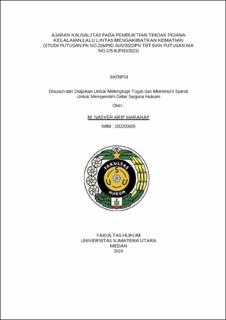| dc.contributor.advisor | Lubis, Rafiqoh | |
| dc.contributor.advisor | Trisna, Wessy | |
| dc.contributor.author | Harahap, M Nasyer Arif | |
| dc.date.accessioned | 2025-03-17T03:01:13Z | |
| dc.date.available | 2025-03-17T03:01:13Z | |
| dc.date.issued | 2025 | |
| dc.identifier.uri | https://repositori.usu.ac.id/handle/123456789/102170 | |
| dc.description.abstract | In the process of proving a crime, an act that can be held criminally accountable must contain an element of fault. The placement of causality is linked to fault, as it is based on the premise that an element of fault influence the consequences of the offender’s actions. Every event that occurs is always preceded by a series of actions that ultimately lead to the event itself, as seen in District Court Decision No. 216/Pid.Sus/2022/PN Tbt and Supreme Court Decision No. 425 K/Pid/2023. This study addresses the following research questions: (1) How are acts classified as traffic and road transportation crimes regulated under Indonesian Law No. 22 of 2009 on Road Traffic and Transportation? (2) How is the doctrine of causality related to determining the fault of a criminal offender under criminal law? (3) What are the judges' considerations in acquittals and sentencing decisions in cases of negligence leading to traffic accidents resulting in death, as analyzed from the perspective of the causality doctrine in Decisions No. 216/Pid.Sus/2022/PN Tbt and No. 425 K/Pid/2023? This research employs a normative juridical method, utilizing secondary data from primary, secondary, and tertiary legal materials obtained through literature study, with qualitative analysis as the chosen method of data interpretation.
The study concludes the following: (1) The regulation of traffic and road transportation crimes is a legal framework governing various violations and offenses in the traffic sector, as stipulated in Indonesian Law No. 22 of 2009. These violations range from administrative infractions to acts endangering public safety. (2) The doctrine of causality aids in proving criminal offenses by assessing both intentional and unintentional forms of fault, as individuals who commit criminal acts bear responsibility based on the presence of fault. (3) In this case, the judge ruled that the defendant was not proven guilty of violating the elements outlined in the Public Prosecutor’s alternative indictment under Article 311 Paragraph 5 and Article 310 Paragraph 4 of Indonesian Law No. 22 of 2009 on Road Traffic and Transportation. The panel of judges concluded that the defendant did not act intentionally when the criminal offense occurred. | en_US |
| dc.language.iso | id | en_US |
| dc.publisher | Universitas Sumatera Utara | en_US |
| dc.subject | Causality | en_US |
| dc.subject | Proof | en_US |
| dc.subject | Negligence | en_US |
| dc.subject | Traffic Accidents | en_US |
| dc.title | Ajaran Kausalitas pada Pembuktian Tindak Pidana Kelalaian Lalu Lintas Mengakibatkan Kematian (Studi Putusan PN No.216/Pid.Sus/2022/PN.Tbt Dan Putusan MA No.425 K/Pid/2023) | en_US |
| dc.title.alternative | The Doctrine of Causality in Proving Traffic Negligence Resulting in Death (Case Study of District Court Decision No. 216/Pid.Sus/2022/PN Tbt and Supreme Court Decision No. 425 K/Pid/2023) | en_US |
| dc.type | Thesis | en_US |
| dc.identifier.nim | NIM200200609 | |
| dc.identifier.nidn | NIDN0025077403 | |
| dc.identifier.nidn | NIDN0123018601 | |
| dc.identifier.kodeprodi | KODEPRODI74201#Ilmu Hukum | |
| dc.description.pages | 110 Pages | en_US |
| dc.description.type | Skripsi Sarjana | en_US |
| dc.subject.sdgs | SDGs 16. Peace, Justice And Strong Institutions | en_US |


